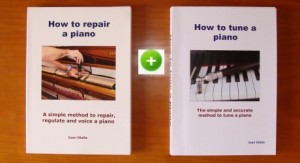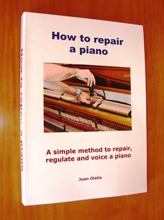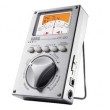The book “How to tune a piano” is made with the aim to teach you to tune pianos the easiest and straightforward possible way.![admin-ajax[1]](https://howtotuneapiano.com/blog/wp-content/uploads/2011/06/admin-ajax11.jpg)
In brief, create a short cut that goes straight to the point. To achieve that, I have deliberately reduced the theory to a minimum, focusing only on the essentials. I have tried to do this the friendly way, imagining that the student is learning next to me and offering comments and advices based on the experience of so many years.
I thought specially on the people that without any previous experience want to learn to tune pianos as a hobby, to tune their own piano or engage in piano tuning as a full or part time profitable and rewarding activity. Also in the experienced professionals that want to update their knowledge or compare their methods with the ones used by other colleagues. Overall, I am confident this book will be useful and beneficial to any music lover interested and curious to know about pianos.
“How to tune a piano” buy and download Now!
$29,95 USD
“How to tune a piano” main Features
- Step by step simple and easy to follow instructions
- Numerous photographs, charts and helpful diagrams
- mp3 samples of the “beats” will show you how to build the temperament
- Dedicated Chapters covering tunning hammer technique exercises
- Plenty of “tips”, short cuts and first hand personal advices
What makes this book special
Is the inclusion of abundant audio-visual material. The student not only read and see the plentiful descriptive colour pictures, but also hear the mp3 sound files which are embedded in the book.
Steps like tuning octaves and unisons, the building of the “temperament” and the practice chapter are accompanied by their respective sound recording, so the student not only read, but also listen and know exactly what to do and how. This advantage let you learn to tune a piano in much shorter time than any other method.
Testimonials
Dear Juan,
I found your book excellent, It is very comprehensive and covers all that a beginner would need to know. Overall it is beautifully presented and I find no fault with it at all. The photographs are very clear and are more than useful to the explanations in the text. It makes me feel confident to have a go myself.
Tom Robinson (England)
Hi Juan,
I have read your books and I think they are very well written in that it is comprehensive with the right amount of detail and helpful diagrams. For those who want to learn to tune and repair pianos, your books will be very useful.
Howard Lock (UK)
Table of contents
Chapter I: Basic tuning tools
This first chapter is devoted to the basic tools to tune a piano. The topics covered are:
Basic tuning kit
The tuning hammer
The tuning fork and rubber wedges
The metronome
The temperament felt strip
Chapter II: Using the tuning hammer
Introduces you without any further preamble in the art of piano tuning and teaches you its mechanics as it is done in practice. The topics are as follow:
Getting the “feel” and control
The right hammer, the right tips
Setting the pins
Setting the strings
Tuning hammer position
Careful not to break the strings
Summary
Chapter III: The main elements, parts and functions
This chapter examines the construction and the main elements of a piano. The idea is to give the student a clear overview of how a piano works. The chapter concludes with cut sections of Grand and Upright piano actions.
The main parts
The sound board
The frame
The cast-iron plate
The pin-block
The action
Chapter IV: Elementary theory, the basics you need to know
This section covers the basic elemental theory you need to know to tune a piano. Very important so that you can understand what it comes later. These are the topics
How the sound is produced
Harmonics and partials
How strings vibrates, the partials
The notes at the piano
Theoretical and real frequencies
The intervals
The unisons
Beats and pulses
Chapter V: Tuning practices
This chapter consist of a series of preliminary exercises to serve you as preparation before you undertake the full piano tuning protocol. You will study the three main intervals needed to set the piano equal temperament to perform a professional and accurate piano tune. You will also learn to tune unisons and octaves and judge by yourself the speed of the piano beat rates.
Tuning unisons
Tuning octaves
How to judge the speed of beat rates
The tuning fork, how to use it
The piano tuner scale
Tuning the main three temperament intervals
False beats, how to deal with them
Chapter VI: Standard piano tuning procedure
This is the fundamental and most extensive chapter of the book. Gradually you will learn how to build the temperament with step by step precise instructions. Here you have all the beat rates needed to build the temperament, conveniently recorded as mp3 files, so the student can easily recognize and judge the piano temperament beat rates without any query or doubt. This section also covers specialized topics of piano tuning like, how to raise the pitch, how to tune a piano to 442, how to do the “stretch”, and so on.
The temperament
Previous preparations
Setting the temperament
Advice and suggestions
Tuning the central section of the keyboard
Tuning the upper section
Tuning the bass section
The “stretch”
Stretch tuning, standard procedure
About raising the pitch
Raising the pitch, modus operandi
Tuning a piano to A442
Chapter VII: Important related topics
Being a piano tuner is not always easy. Sometimes we find ourselves in relatively uneasy situations. This chapter discusses the difficulties we may encounter and how to deal with them.
Tuning at a concert
Aural tuning versus electronic tuning
Specific electronic tuners, its main applications
Summary
Chapter VIII: Managing a piano tuner business, the best advice
This chapter is aimed to all of you who want to engage in piano tuning as a profession. A practical guideline on how to successfully manage your business as piano technician. The author of the book, gives specific advices and last recommendations for the future piano tuner, based on his own experience.
Promoting your business, get yourself known
Build a customer data base
The price issue
Exceptions to the rule
Learning to play the piano
Tune as many pianos as possible
Properly managing your working time
Building trust
The odd job
Piano tuning is a seasonal work
The best you can
Buy the two eBooks Now and save a 15% - Instant download!
 $50,92 USD $50,92 USD |
Have you got any questions/comments about this book? Please, let us know.
© copyright 2011 Juan Olalla All rights reserved www.howtotuneapiano.com





